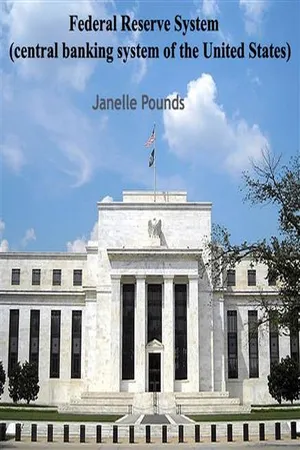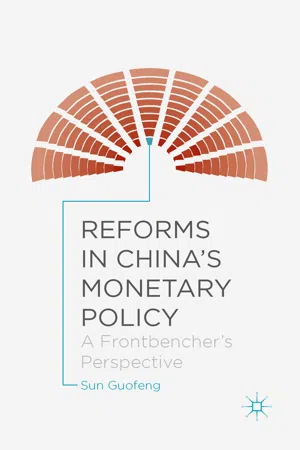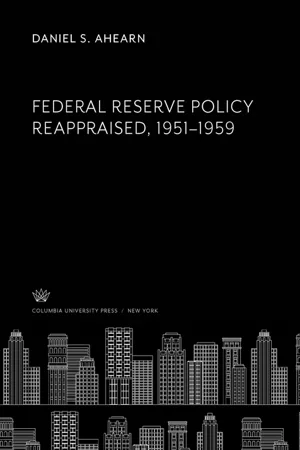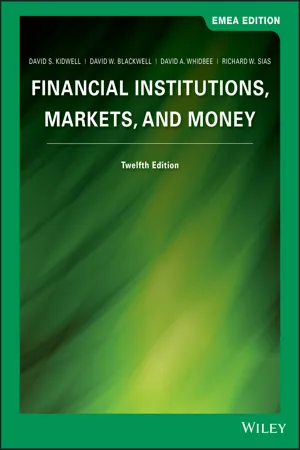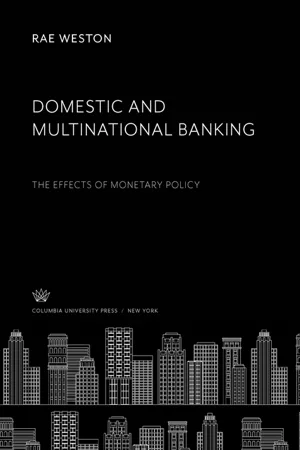Economics
Bank Reserves
Bank reserves refer to the funds that financial institutions are required to hold in reserve to meet potential withdrawals and liabilities. These reserves are typically held in the form of cash or deposits with the central bank. By regulating the level of reserves, central banks can influence the money supply and control inflation.
Written by Perlego with AI-assistance
Related key terms
1 of 5
9 Key excerpts on "Bank Reserves"
- eBook - ePub
- Indranarain Ramlall(Author)
- 2018(Publication Date)
- Emerald Publishing Limited(Publisher)
It is of paramount significance to note that the building up of reserves tends to be a coveted task for countries which are deficient in natural resources as only reserves can act as buffer to cushion these countries from external shocks. Countries which have resources based on natural resource endowments tend to be subject to less stressful conditions in the case of external shocks as they can deplete these resources to accommodate for any pressing external repayments.Since banks often lie at the apex of the financial intermediation roles in many parts of the world, banks’ reserves necessitate a meticulous analysis in the form of liquidity reserves and capital reserves. Unfortunately, neither liquidity reserves nor capital reserves were ample to cushion the detrimental impacts of the global financial crisis on the banks. To cater for such a deficiency, liquidity reserves in the form of net stable funding ratio and liquidity coverage ratio have been recommended by Basel III. Similarly, to remedy for the fact that both liquidity and capital reserves were not effective in dealing with different phases of the business cycles, the countercyclical capital buffer has been introduced by Basel III. Likewise, a capital surcharge has been recommended by Basel III to cope with systemically important financial institutions.3.2. Definition of Reserves
Reserves can be defined as the holding of assets to meet any unforeseen contingencies as and when they fall due. Such a definition signifies that different asset types such as currencies, fixed deposits, real estates, commodities and exchange traded funds can all fall under the purview of reserves. The type of assets held under reserves will vary as per the group of economic units under focus. For instance, reserves held by a household will tend to be more tilted towards real estate assets while those held by central banks will tend to be more tilted towards foreign assets such as internationally accepted currencies and gold. In essence, reserves are held by households, banks, governments, corporates and even central banks. At the economy level, reserves can be endowed or acquired. Endowed reserves constitute reserves which can easily be mined in an economy such as gold mines in South Africa. Acquired reserves represent reserves which are acquired following strenuous economic activities unleashed by a country such as the presence of a robust exporting sector which brings in regular inflows of foreign currencies. Robust holdings of reserves by a specific economic unit enables the latter to best cope with unanticipated shocks likely to generate detrimental impacts, and with these impacts differing as by the type of economic unit under scrutiny. For banks, the shocks manifest in the form of capital erosion, for households, the shocks take the form of subdued probability of being solvent on loans, for corporates, the shock take the form of undermined repayment capacity on loans and, finally, for government, the shocks culminate into heightened public debt levels. - No longer available |Learn more
- (Author)
- 2014(Publication Date)
- White Word Publications(Publisher)
If in response a bank could not raise enough funds by calling in loans or selling bills, it either went into insolvency or defaulted on its notes. Such a situation is called a bank run and caused the demise of many early banks. Repeated bank failures and financial crises led to the creation of central banks – public institutions that have the authority to regulate commercial banks, impose reserve requirements, and act as lender-of-last-resort if a bank runs low on liquidity. The emergence of central banks mitigated the dangers associated with fractional reserve banking. Reason for existence Fractional reserve banking allows people to invest their money, without losing the ability to use it on demand. Since most people do not need to use all their money all the time, banks lend out that money, to generate profit for themselves. Thus, banks can act as financial intermediaries — facilitating the investment of savers' funds. Full reserve banking, on the other hand, does not allow any money in such demand deposits to be invested (since all of the money would be locked up in reserves) and less liquid investments (such as stocks, bonds and time deposits) lock up a lenders money for a time, making it unavailable for the lender to use. According to mainstream economic theory, regulated fractional-reserve banking also benefits the economy by providing regulators with powerful tools for manipulating the money supply and interest rates, which many see as essential to a healthy economy. Member banks which fall under the umbrella of central bank regulation have different bankruptcy regulation than a typical business. For this reason the demand deposits of most banks will retain their value in spite of circumstances which would otherwise jeopardize their credit-worthiness. - eBook - PDF
Introduction to Finance
Markets, Investments, and Financial Management
- Ronald W. Melicher, Edgar A. Norton(Authors)
- 2020(Publication Date)
- Wiley(Publisher)
When Bank Reserves differ from required reserves, a depository institution has either excess reserves or deficit reserves. Excess reserves occur when the amount of a depository institution’s Bank Reserves exceed required reserves. If required reserves are larger than the Bank Reserves of an institution, the difference is called deficit reserves. The banking system will have excess reserves if the cumulative amount of Bank Reserves for all depository institutions exceeds the total required reserves amount. Two kinds of factors affect total reserves: those that affect the currency holdings of the banking system and those that affect deposits at the Fed. Currency flows in response to changes in the demand for it by households and businesses. Reserve balances are affected by a variety of transactions involving the Fed and banks, and that may be initiated by the banking system or the Fed, the Treasury, or other factors. Although the Fed does not control all of the factors that affect the level of Bank Reserves, it does have the ability to offset increases and decreases. Thus, it has broad control over the total reserves avail- able to the banking system. Figure 5.2 provides a summary of the transactions that affect Bank Reserves. Discussion of these transactions follows. 5.7.1 CHANGES IN THE DEMAND FOR CURRENCY Currency flows into and out of the banking system affect the level of reserves of the banks receiving the currency for deposit. Let’s assume that an individual or business finds they have excess currency of $100 and deposit it in Bank A. Deposit liabilities and the reserves of Bank A are increased by $100. The bank now has excess reserves of $80, assuming a 20% level of required reserves. These reserves can be used by the banking system to create $400 in additional deposits. If the bank does not need the currency but sends it to its Reserve Bank, it will receive a $100 credit to its account. The volume of Federal Reserve notes in circulation is decreased by $100. - eBook - PDF
- John E. Marthinsen(Author)
- 2020(Publication Date)
- De Gruyter(Publisher)
A $10 million cash withdrawal would reduce the bank ’ s re-serves by $10 million, but its required reserves would fall only by $1 million. As a result, the bank would hold reserves of $90 million, but its required reserves would equal $99 million. 12 Therefore, the bank would be $9 million below the reserves required. The takeaway from this discussion is that the reserve ratio is a monetary tool that allows central banks to control the ability of financial intermediaries to create money. It does not protect banks and depositors from bank runs or provide banks with extra funds to meet extraordinary customer withdrawals. 12 Before the withdrawal, the reserve requirement was 10% of deposits worth $1,000 million, which equaled $100 million. Afterward, they are 10% of deposits worth $990 million, which equals $99 million. Therefore, required reserves fall by only $1 million. Monetary Tools of the Central Bank 211 Interest Return on Bank Deposits (Reserves) at the Central Bank Central banks determine not only the size of the reserve ratio and the particular assets that qualify as reserves but also the interest rate (if any) they give on de-posited Bank Reserves. Cash that banks hold in their vaults earns no interest, but bank deposits at the central bank may earn a small return. For most of the U.S. Federal Reserve ’ s history, bank deposits at the Fed received no interest, but in 2008, the Fed changed its policy and began paying banks interest on their deposited reserves. 13 Depositing funds at the central bank has one significant advantage, which is the near absence of counterparty risk. Central banks should always be able to repay their obligations — mainly because they can create enough funds to extin-guish their liabilities. Therefore, when a central bank raises the interest it gives on deposited Bank Reserves, the banking system responds by holding more ex-cess reserves (i.e., they increase the preferred asset ratio, ER/D) and, thereby decrease the money multiplier. - eBook - PDF
Reforms in China's Monetary Policy
A Frontbencher's Perspective
- Sun Guofeng(Author)
- 2016(Publication Date)
- Palgrave Macmillan(Publisher)
The central bank conducts liquidity management operations to stabilize the value of the currency, which can be regarded as a tax levied on commercial banks. The central bank uses the institutional arrangement of the required reserve ratio to create a structural liquidity deficit, which is power given by laws. The central bank imposes compulsory measures on commercial banks to manage reserves and money and establishes an exogenous digital connection between deposits (the major constituent of money) and reserves (by which the cen- tral bank can control its own liabilities) to control the money supply and the interest rate. The key to this digital connection lies in the central bank creat- ing a structural liquidity deficit by setting the required deposit reserves ratio at a level slightly higher than the supply of reserves. Commercial banks in developed countries have a very low level of demand for excess reserves, and the demand for required reserves basically represents total reserves demand. The main function of the required reserve ratio is liquidity management, and if the required reserve ratio is significantly lower than the level of reserves held by commercial banks, making total reserves demand lower than the sup- ply of reserves and ensuring the banking system has a liquidity surplus, then the central bank is required to reduce the supply of liquidity to balance the demand and supply of reserves. In this case, the compulsory digital connection between reserves and deposits of the required reserve ratio no longer exists. The function of the required reserves system not only lies in creating liquidity deficit, but also lies in stabilizing the demand for reserves. The Monetary Theory ● 49 required reserves systems of developed countries usually assess the reserve ratio requirements according to the average value or the value at the end of a prescribed period. - Daniel S. Ahearn(Author)
- 2019(Publication Date)
- Columbia University Press(Publisher)
Member banks are unable to lend as much as nonmember banks or nonbank lenders out of a given deposit because more is required of them as a cash reserve. This in turn means that a corre-spondingly larger proportion of member banks' total resources must be held in nonearning cash, reducing their ability to attract time de- 158 USE OF MONETARY INSTRUMENTS posits by paying competitive rates of interest 32 and also their ability to earn profits and thus grow. The Federal Reserve has explained its policy of making only re-ductions in bank reserve requirements in recent years on the grounds that they had been raised too high 33 and that tying up too much of the banks' assets in cash has adverse implications for the future stability and growth of the economy. The Federal Reserve set out its position in a 1959 statement to the Joint Economic Committee in the following language: Long-term growth in the demand-deposit component of the money sup-ply requires not only an adequate supply of reserves to the banking sys-tem but also provision for an adequate capital structure. If deposits and risk assets grow more rapidly than the capital accounts, this gradually undermines the protection against loss that these capital accounts pro-vide, first to the depositors, and second to the Government, the insurer of deposits through the FDIC. The ratio of capital to liabilities and risk assets in the banking system will not be affected much, one way or the other, by monetary policy actions in the short run. In the longer run, however, the level of reserve requirements, along with many other fac-tors, will play a part in determining the rate at which banks are able to add to their capital, either by retained earnings or the attraction of new investment. 34 However, a number of congressmen and economists have appeared to take the view that whatever problems the banks may have, they should solve these themselves.- eBook - PDF
Financial Institutions
Markets and Money
- David S. Kidwell, David W. Blackwell, David A. Whidbee, Richard W. Sias(Authors)
- 2020(Publication Date)
- Wiley(Publisher)
Thus, the banking system is fully “loaned” up—it cannot make any additional loans or investments because there are no excess reserves available. Banks are motivated to keep their excess reserves near zero because in this example, the Fed does not pay interest on reserves held at the Fed. Now suppose the Fed buys $30 billion in government securities in an open‐market transaction and pays for them by giving banks $30 billion more in reserve deposits at the Fed (see center frame of Exhibit 3.2). Thus, the total reserves held in the banking system increase from $60 billion to $90 billion, investments are reduced by $30 billion, and initially, banks EXHIBIT 3.1 Money Supply Measures M1 = currency + checking deposits + Traveler’s checks M2 = M1 + savings deposits, money market deposit accounts, noninstitutional money market mutual funds, and small time deposits The M1 definition of money emphasizes money as a medium of exchange; M2 emphasizes money as a store of value. Other measures exist, but M1 and M2 are the most useful definitions of money when conducting monetary policy. 74 CHAPTER 3 The Fed and Interest Rates now hold $30 billion in excess reserves ($90 billion – $60 billion = $30 billion) because deposits are $600 billion. Being profit maximizers, banks try to spend any excess reserves they hold by making more loans and buying investments that pay an interest return. When a bank makes a loan, it gives a transaction deposit to the borrower or gives the borrower a check. When the check is cashed, either the borrower’s transaction deposits increase or the transaction deposits of the person the borrower gave the check to increase. In all cases, total transaction deposits in the banking system increase when a bank uses some of its excess reserves to make a loan. Conversely, if a loan is repaid, the checking account of the person who repays the debt decreases when the bank cashes the check, and so do total transaction deposits unless the bank makes more loans. - eBook - ePub
- International Monetary Fund(Author)
- 1996(Publication Date)
- INTERNATIONAL MONETARY FUND(Publisher)
An alternative framework is based on the assumption that each country faces a schedule that determines the terms under which reserves are supplied to that country. In most cases the relevant supply conditions are the terms on which the country can obtain credit in international financial markets. Thus, reserve holdings are, for most countries, seen as one aspect of an increasingly sophisticated strategy of financial management. This framework also suggests that reserves, per se, play a much more important role in the policies of countries that are effectively excluded from participating in private financial markets. For unconstrained countries, the cost of holding reserves can be compared to the spread between the marginal cost of obtaining credit and the rate of return earned on their reserve assets. For countries with limited or no access to credit markets the cost of obtaining reserves is related to the requirement that their net receipts from goods and services traded with the rest of the world be altered.This way of looking at the problem introduces a number of interesting questions about the provision and composition of reserve holdings in the current system. A general review of recent developments in the pattern of reserve holdings reinforces the view that the apparent relationships between reserve holdings and other important economic variables have continued to conform to historical experience. However, there are alternative interpretations of these developments. While it may have been useful in the past to interpret reserve holdings as being demand determined, this is not a useful interpretation in the current system. The view that reserve holdings are, for most countries, an element in a more general financial strategy is developed further in the final section of this paper in the context of the management of the currency composition of reserve assets.Passage contains an image
Comment
Willem H. Buiter - eBook - PDF
Domestic and Multinational Banking
The Effects of Monetary Policy
- Rae Weston(Author)
- 2019(Publication Date)
- Columbia University Press(Publisher)
Even Bagehot, in The Nature of Banking 21 recognising the accomplished fact of the Bank's role as lender of last resort, commented that he would have preferred this last resort respon-sibility to have been spread among a number of equally sized leading banks. Once accepted as a responsibility by the Bank of England, the lender of last resort function came to be taken as a role of central banks to the extent that the US Federal Reserve Banks automatically assumed this responsibility on their establishment. The discount rate, often referred to as the Bank rate, remained a primary instrument of control into the present century; however, on a number of occasions when liquidity was high, the Bank of England found it very difficult to implement effective discount rate changes. On such occasions the Bank withdrew funds from the discount market by selling Consols (Consolidated Government stock) for cash and buying them back for the period of monthly settle-ment that was unexpired. Sayers 5 describes the procedures for reducing the available money supply as piecemeal rather than systematic and says that the sheer diversity of techniques employed suggested that the Bank was not satisfied with any of them. As liquidity became an increasing characteristic of the system, the Bank of England began to use open market operations to facilitate the effectiveness of discount rate policy and the Federal Reserve System, on its establishment in 1913, was authorised to use open-market opera-tions as a supplement to discount rate policy. Variable reserve requirements appear to have been first used in the United States which in 1933 legislated to provide that commercial banks should maintain minimum credit balances of fixed percentages of their demand and time deposits, and in 1935 legislated to give the Federal Reserve power to vary these reserve requirements from time to time, within limits above the normal minimum reserve ratios.
Index pages curate the most relevant extracts from our library of academic textbooks. They’ve been created using an in-house natural language model (NLM), each adding context and meaning to key research topics.

